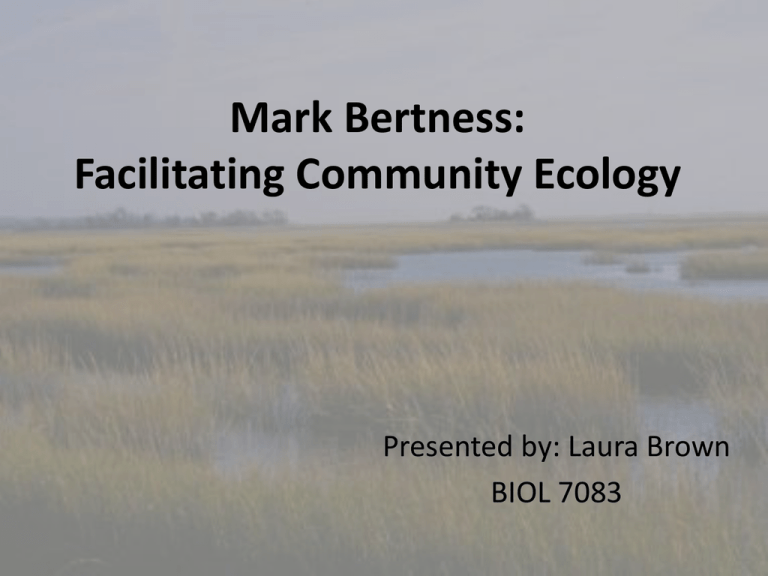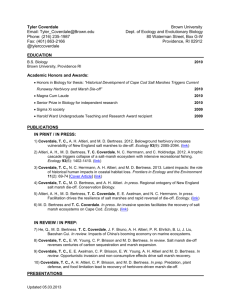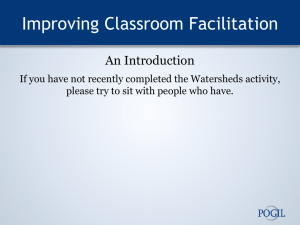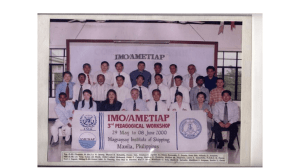pptx
advertisement

Mark Bertness: Facilitating Community Ecology Presented by: Laura Brown BIOL 7083 Background • Born July 13, 1949 WA • B.S. University of Puget Sound (psychology/chemistry) • M.S. Western Washington University (Biology) • Ph.D University of Maryland (evolutionary ecology) Geerat Vermeij Tree Brian Silliman John Bruno Jonathan M. Levine ME! Research Overview • Consumer control of salt marshes • Human impacts on coastal ecosystems • Role of foundation species and positive interactions in community organization • Climate change impacts on coastal ecosystems • Historical states of impacted ecosystems Cross section of a southern New England salt marsh illustrating the major vegetation zones and general results of this paper. Increasing Competition ©2002 by National Academy of Sciences Increasing Physical Constraints Bertness M D et al., 2002 Spartina alterniflora Zone Spartina alterniflora Zone Spartina alterniflora Zone Spartina alterniflora Zone Spartina alterniflora Zone Treatment Number of Stems Biomass (g) With Fiddlers 23.1±2.4 20.6±2.5 Without Fiddlers 13.3±1.4 15.7±1.8 • Roots and rhizomes provide structural support • Increases above ground biomass • Soil drainage • Soil oxidation reduction potential • In situ decomposition of belowground plant debris • Facilitative Mutualism! Bertness 1985 Spartina patens Zone Spartina patens Zone Lower bound is set by environmental stress Bertness 1991 Spartina patens Zone Bertness 1991 Juncus gerardii Zone Wrack! Salicornia and Distichlis Juncus Zone • Initial colonizers • Shade substrate • Alleviate salt stress Bertness and Shumway 1993 Bertness 1992 Rocky Intertidal Bertness 1989 Community Structure • • • • • • Time Spatial heterogeneity Competition Predation Climatic stability Productivity • Predation Hypothesis – Dominant predators keep species diversity high by reducing monopolizers • Competition hypothesis – Highly diverse communities arise in environments that are stable and result from competition managed niches Menge and Sutherland 1976 Menge and Sutherland 1987 Community Structure Menge and Sutherland 1987 Positive interactions in communities Bertness and Callaway 1994 “Current concepts of the role of interspecific interactions in communities have been shaped by a profusion of experimental studies of interspecific competition over the past few decades. Evidence for the importance of positive interactions- facilitations- in community organization and dynamics has accrued to the point where it warrants formal inclusion into community ecology theory, as it has been in evolutionary biology.” The greater influence between competition and positive interactions? Bertness and Callaway 1994 Facilitation Study Type Benthics % MEPS % Facilitation 3.4 2.2 Predation 15.1 10.6 Propagule Supply 12.3 6.1 Disturbance 6.8 4.2 Competition 2.7 1.2 Shaded = Facilitation Open = Competition Brooker et al., 2008 Facilitation • Niche Concept • S. alterniflora zone stabilization Bruno, Stachowicz and Bertness 2003 Facilitation • Niche Concept • S. alterniflora zone stabilization • Environmental Stress • Desert shrubs reduce soil temp, but outcompete for shade Bruno, Stachowicz and Bertness 2003 Facilitation • Niche Concept • S. alterniflora zone stabilization • Environmental Stress • Desert shrubs reduce soil temp, but outcompete for shade • Invasibility with higher richness Bruno, Stachowicz and Bertness 2003 Facilitation • Niche Concept • S. alterniflora zone stabilization • Environmental Stress • Desert shrubs reduce soil temp, but outcompete for shade • Invasibility with higher richness • Keystone species • Intermediate Disturbance Hypothesis • Keystone species and species within those species Bruno, Stachowicz and Bertness 2003 Facilitation Community Structure Menge and Sutherland 1987 Facilitation Intraspecific Interspecific Bruno, Stachowicz and Bertness 2003 Conclusion Competition Predation Facilitation Mark Bertness Citations • • • • • • • • • • • Bertness, M.D. 1985. Fiddler crab regulation of Spartina alterniflora production on a New England salt marsh. Ecology 66:1042-1055. Bertness, M.D. 1989. Intraspecific competition and facilitation in a northern acorn barnacle population. Ecology 70:257-268. Bertness, M.D. 1991. Zonation of Spartina patens and Spartina alterniflora in a New England salt marsh. Ecology 72:138-148. Bertness, M.D. 1992. Ecology of New England salt marsh. American Scientist 80:260-268. Bertness, M.D., P.J. Ewanchuk and B.R. Silliman. 2002. Anthropogenic modification of New England salt marsh landscapes. 99:13985-1398. Bertness, M.D. and R. Callaway. 1994. Positive interactions in communities. Tree 9:191-193. Bertness, M.D. and S.W. Shumway. 1993. Competition and facilitation in marsh plants. The American Naturalist 142:718-724. Brooker, R.W. F.T. Maestre, R.M. Callaway, C.L.Lortie, L.A. Cavieres, G. Kunstler, P. Liancurt, K. Tielborger, J.M.J. Travis, F. Anthelme, C. Armas, L. Coll, E. Corcket, S. Delzon, E. Forey, Z. Kikvidze, J. olofsson, F. Pugnaire, C.L. Quiroz, P. Saccone, K. Schiffers, M. Seifan, B. Touzard, and R. Michalet. 2008. Journal of Ecology 96:18-34. Bruno, J.F., J.J. Stachowicz, and M.D. Bertness. 2003. Inclusion of facilitation into ecological theory. Trends in Ecology and Evolution 18:119-125 Menge, B.A. and J.P. Sutherland. 1976. Species diversity gradients: synthesis of the roles of predation, competition, and temporal heterogeneity. The American Naturalist 110:351-369. Menge, B.A. and J.P. Sutherland. 1987. Community regulation: variation in disturbance, competition, and predation in relation to environmental stress and recruitment. The American Naturalist 130:730-757.







